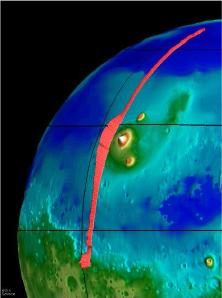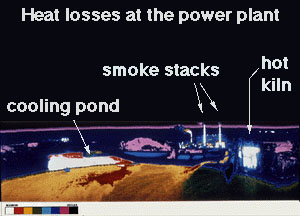Exploratour - The Surface of Mars
Click on image for full size
NASA/JPL
Tharsis Ridge
This picture shows the Tharsis Ridge, the green/blue area in the middle of the picture, as well as a portion of the southern hemisphere of Mars. The green areas are more elevated than the surroundings, and the yellow/white regions, which are actually Martian volcanoes, are the most elevated of all. The red line in the picture is the spacecraft measurement which indicates just how large the regions are compared to one another.
The Tharsis Ridge is a region about twice the size of the United States (8000 km), and is where many of the volcanoes of Mars are found. Measurements by all spacecraft visiting Mars, including recent ones by Mars Pathfinder and Mars Global Surveyor, have indicated that this region of Mars is actually a giant bulge, as shown in the picture. The picture also shows how much more elevated the southern hemisphere of Mars is from the rest of the planet.
The Ridge probably formed about 3.8 Billion years ago, about 250 million years after Mars finished forming out of the solar nebula. Even though that is a very long time ago, scientists regard this period as somewhat late in Mars' history. This means that Mars probably had a late warming episode, which created the Ridge, with it's associated volcanoes.
The Ridge may have been built in a manner similar to the volcanic rises of Venus, namely by a rising hot plume from the deep interior, which formed land on the surface. The cratering record suggests that after this period of activity, all volcanic activity on Mars ceased. There seem to be no features younger than 3.5 Billion Years.












